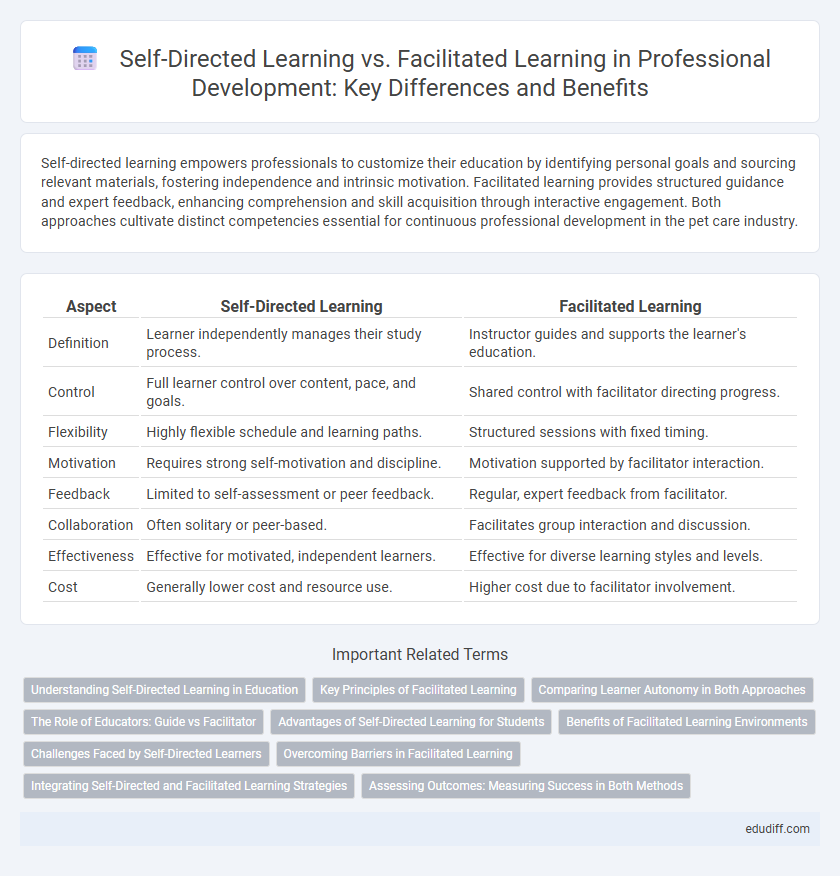Self-directed learning empowers professionals to customize their education by identifying personal goals and sourcing relevant materials, fostering independence and intrinsic motivation. Facilitated learning provides structured guidance and expert feedback, enhancing comprehension and skill acquisition through interactive engagement. Both approaches cultivate distinct competencies essential for continuous professional development in the pet care industry.
Table of Comparison
| Aspect | Self-Directed Learning | Facilitated Learning |
|---|---|---|
| Definition | Learner independently manages their study process. | Instructor guides and supports the learner's education. |
| Control | Full learner control over content, pace, and goals. | Shared control with facilitator directing progress. |
| Flexibility | Highly flexible schedule and learning paths. | Structured sessions with fixed timing. |
| Motivation | Requires strong self-motivation and discipline. | Motivation supported by facilitator interaction. |
| Feedback | Limited to self-assessment or peer feedback. | Regular, expert feedback from facilitator. |
| Collaboration | Often solitary or peer-based. | Facilitates group interaction and discussion. |
| Effectiveness | Effective for motivated, independent learners. | Effective for diverse learning styles and levels. |
| Cost | Generally lower cost and resource use. | Higher cost due to facilitator involvement. |
Understanding Self-Directed Learning in Education
Self-directed learning empowers students to take initiative, set goals, and evaluate their progress independently, fostering critical thinking and lifelong learning skills. This approach contrasts with facilitated learning, where instructors guide the process, providing structured content and feedback. Emphasizing autonomy in education enhances motivation and engagement, crucial for adapting to diverse learning styles and evolving professional demands.
Key Principles of Facilitated Learning
Facilitated learning emphasizes active collaboration between the learner and facilitator, where the facilitator guides the learning process by providing resources, feedback, and encouragement to enhance critical thinking and problem-solving skills. Key principles include learner-centered approaches, fostering autonomy while maintaining structured support, and promoting reflection to deepen understanding. This method contrasts with self-directed learning by balancing learner independence with strategic facilitator involvement to optimize educational outcomes.
Comparing Learner Autonomy in Both Approaches
Self-directed learning emphasizes learner autonomy by allowing individuals to set goals, choose resources, and pace their study, fostering intrinsic motivation and personal responsibility. Facilitated learning involves guided instruction and support from educators, which can limit autonomy but enhance structure and clarity for learners needing direction. Comparing both, self-directed learning maximizes control over the learning process, while facilitated learning provides necessary scaffolding, balancing learner independence with expert guidance.
The Role of Educators: Guide vs Facilitator
Educators in self-directed learning act as guides, providing resources and support to empower learners to take ownership of their educational journey. In facilitated learning, educators function as facilitators, actively engaging with students to foster collaboration and deeper understanding through structured activities. The shift from authoritative instruction to partnership emphasizes personalized learning pathways and critical thinking development.
Advantages of Self-Directed Learning for Students
Self-directed learning empowers students to take control of their educational journey, fostering critical thinking and problem-solving skills essential for lifelong learning. This approach enhances motivation by allowing learners to pursue topics aligned with their interests and pace, improving retention and engagement. Furthermore, self-directed learning cultivates adaptability and independence, preparing students to navigate complex professional environments effectively.
Benefits of Facilitated Learning Environments
Facilitated learning environments enhance knowledge retention by providing structured guidance and expert feedback, fostering deeper understanding and critical thinking skills. These environments encourage collaboration and active participation, promoting diverse perspectives and problem-solving abilities. The presence of a skilled facilitator helps maintain motivation and accountability, improving overall learning outcomes and engagement.
Challenges Faced by Self-Directed Learners
Self-directed learners often encounter challenges such as lack of structured guidance, difficulty maintaining motivation, and limited access to immediate feedback. Without a facilitator, these learners may struggle with organizing content, setting realistic goals, and evaluating their own progress effectively. Overcoming these obstacles requires strong self-discipline, time management skills, and proactive resource seeking to ensure continuous development.
Overcoming Barriers in Facilitated Learning
Overcoming barriers in facilitated learning requires addressing challenges such as limited participant engagement, diverse learning paces, and varying levels of prior knowledge. Effective facilitators utilize adaptive techniques, including personalized feedback and interactive activities, to foster a supportive learning environment. Leveraging technology and continuous assessment helps to identify obstacles early, ensuring targeted interventions that enhance learner comprehension and motivation.
Integrating Self-Directed and Facilitated Learning Strategies
Integrating self-directed and facilitated learning strategies enhances learner autonomy while providing structured guidance to optimize knowledge acquisition. Self-directed learning encourages critical thinking and personalized pacing, whereas facilitated learning offers expert feedback and collaborative opportunities that reinforce understanding. Combining these approaches creates a dynamic educational environment that adapts to diverse learner needs and maximizes overall engagement and retention.
Assessing Outcomes: Measuring Success in Both Methods
Assessing outcomes in self-directed learning involves evaluating individual goal achievement, knowledge retention, and the ability to apply skills independently using tools such as portfolios, self-assessments, and reflective journals. Facilitated learning outcomes are typically measured through standardized tests, facilitator observations, peer feedback, and performance assessments aligned with predetermined learning objectives. Combining these metrics provides a comprehensive assessment framework that captures both autonomous learner growth and guided instructional effectiveness.
Self-Directed Learning vs Facilitated Learning Infographic

 edudiff.com
edudiff.com